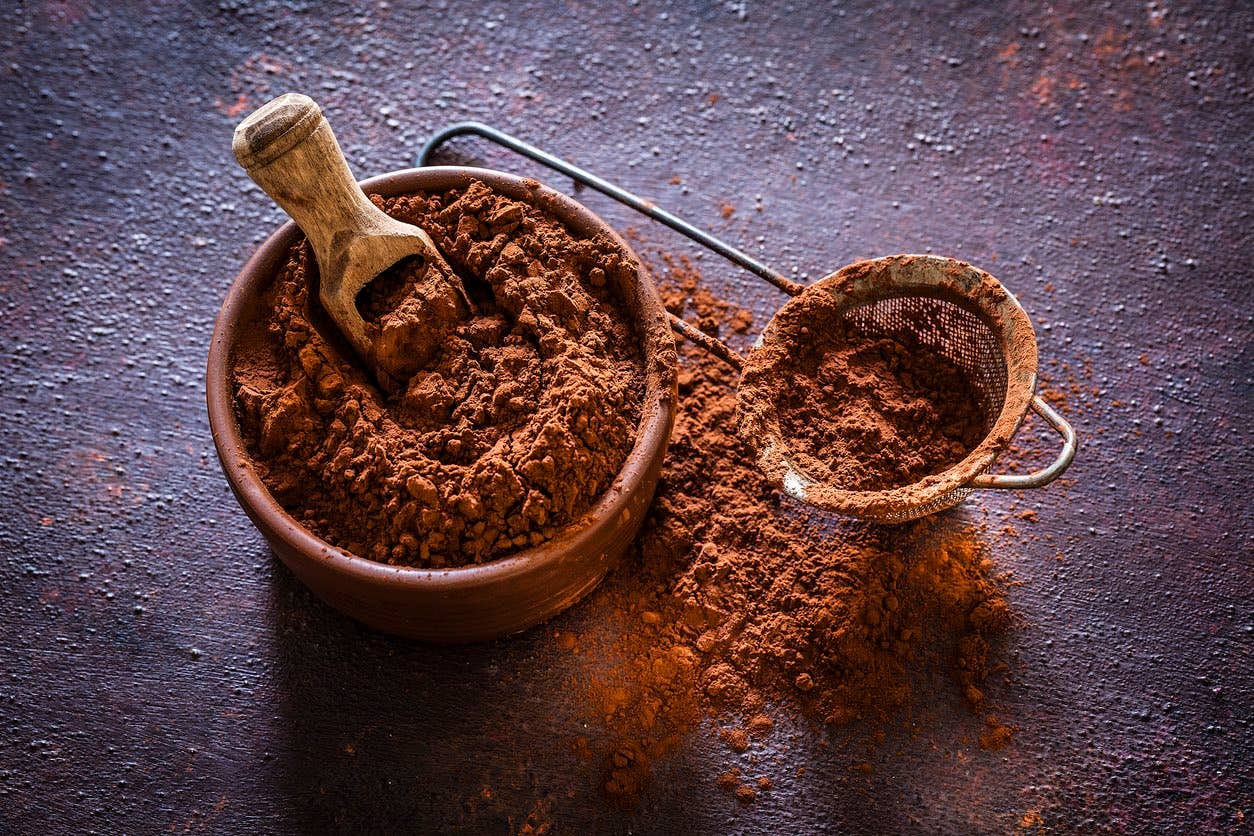
Cocoa vs. Cacao vs. Dutch-Processed: What’s the Difference—and Does It Matter?
- Cocoa is roasted and pressed, cacao is cold-pressed from raw beans, and Dutch-processed cocoa is alkalized to neutralize acidity.
- Processing affects flavor and nutrition: Cacao retains the most antioxidants.
- Substitution in recipes (especially baking) may require adjusting for acidity.
If you've ever paused mid-recipe wondering, “Can I use cocoa powder instead of cacao?” or “What even is Dutch-processed cocoa?”, you're not alone. These chocolaty powders may look similar, but there are meaningful differences among them—especially when it comes to nutrition and how they perform in recipes.
Since many of us reach for one of these powders regularly, for smoothies, baked goods, or no-bake treats, it’s worth understanding what sets them apart and when to choose one over the others.
Can You Swap Cocoa Powder for Cacao? What About Dutch-Processed?
Let’s clear up the most pressing question first: In most recipes—smoothies, chia pudding, nice cream, raw brownies, and many baked goods—you can use cacao powder, natural cocoa powder, and Dutch-processed cocoa interchangeably. But there’s one important exception: recipes that rely on baking soda as the sole leavening agent.
Baking soda is naturally basic; it needs acid to activate and produce lift. Natural cocoa powder is acidic enough to react with baking soda and help baked goods rise. The acidic profile of cacao powder can vary significantly, and Dutch-processed cocoa is actually neutral, so they won't activate baking soda on their own. If you use Dutch-processed cocoa or cacao powder in a recipe that relies on baking soda, you’ll need to include a small amount of acid, such as a teaspoon of vinegar or lemon juice, to ensure proper leavening.
This isn’t an issue in recipes that also include baking powder, which already contains its own acid. In those cases, the baking powder provides the leavening boost, so the cocoa’s acidity (or lack thereof) matters less.
How Each Powder Is Made
All three powders start with fermented cacao beans, but their processing methods differ, affecting both their flavor and their nutritional content.
- Cacao powder is made by cold-pressing raw, fermented cacao beans to remove most of the fat (cocoa butter). This minimal processing helps preserve more of the beans’ original nutrients. Some brands are not truly raw; the beans are lightly roasted before pressing.
- Natural cocoa powder (often called just “cocoa powder” on product labels) is made by roasting fermented beans at 250°F to 350°F before pressing out the cocoa butter. Roasting mellows the flavor but reduces the number of antioxidants.
- Dutch-processed cocoa begins as natural cocoa powder but is treated with an alkaline solution to neutralize its acidity. This results in a darker color, smoother flavor, and reduced bitterness—but also a significant loss of antioxidants.
Flavor Differences
The flavor differences can be subtle—I’m a professional recipe developer and I, for one, can’t taste much difference among the three types of powder in the recipes I make—but here’s a general breakdown.
- Cacao powder: bold, somewhat bitter, earthy
- Natural cocoa: strong, slightly acidic, classic chocolate flavor
- Dutch-processed cocoa: smoothest and mildest taste, with less bitterness
Flavor also depends on factors like the type of bean used, roasting method, and degree of alkalization.
Which Is Healthiest?
Cacao powder is often marketed as the healthiest option, and lab tests show it contains significantly more flavonoids and polyphenols than natural cocoa. However, the degree to which these nutrients are absorbed and utilized by the body compared with those in natural cocoa remains an open question.
One thing is clear from research: The alkalization process used in Dutch-processing destroys 60% or more of natural cocoa powder's antioxidants. If antioxidant content is your priority, cacao comes out on top—followed by natural cocoa powder. Dutch-processed cocoa ranks last by a wide margin.
Health Benefits of Cocoa Powder
In How Not to Age, Michael Greger, M.D., FACLM, highlights the potential health benefits researchers have found for natural cocoa powder, with special relevance for aging populations. Clinical studies suggest that natural cocoa powder may help to:
- Reduce inflammation and oxidative stress
- Boost levels of brain-derived neurotrophic factor (BDNF), a key protein for brain health
- Improve muscle mass, grip strength, and physical function in older adults
- Support skin elasticity, thickness, density, and hydration, while reducing wrinkle depth
- Improve visual sharpness
Several studies showed that Dutch-processed cocoa did not lead to the same health benefits. While most of these studies focus on natural cocoa powder rather than cacao, the findings suggest that adding natural cocoa powder or cacao powder to your diet, in most cases 2–3 teaspoons a day, can be a small but powerful health upgrade.
Shopping and Storage Tips
When shopping for cacao, cocoa, or Dutch-processed cocoa powder, check the label closely to see exactly what you’re getting. It’s not always apparent at first glance. Choose a brand with no added sugar or dairy. For cacao powder, try Navitas Organics or Terrasoul Superfoods—both offer rich, minimally processed options. For natural cocoa, Hershey’s is budget-friendly, while Ghirardelli adds depth. For Dutch-processed, Valrhona delivers exceptional flavor and rich color.
Once home, store cocoa powder in an airtight container in a cool, dark place, such as a pantry. Avoid the refrigerator, which can introduce moisture and cause clumping. Stored properly, cocoa powder stays fresh for up to two years without losing its flavor or potency.
Bottom Line
While cacao powder boasts the highest antioxidant levels, natural cocoa powder remains a savvy, well-rounded choice for everyday use. It’s more budget-friendly, easy to find, and still packs a respectable antioxidant punch. Its natural acidity makes it a better match for baking, and its rich, familiar flavor shines in everything from brownies to to homemade fudge sauce.
About the Author

About the Author
Linda Tyler
Linda Tyler is a plant-based cooking instructor, recipe developer, and writer. She is the author of The Plant-Based Anti-Inflammatory Cookbook and Cook Once, Eat Better. She teaches cooking classes for Portland Community College in Oregon and offers one-on-one plant-based lifestyle coaching. She has published recipes in vegan magazines and websites as well as articles on animal welfare issues. She is on the video review team for NutritionFacts.org. For more information, see www.graciousvegan.com.
Join our mailing list
Get free recipes and the latest info on living a happy, healthy plant-based lifestyle.
By providing your email address, you consent to receive newsletter emails from Forks Over Knives. We value your privacy and will keep your email address safe. You may unsubscribe from our emails at any time.
